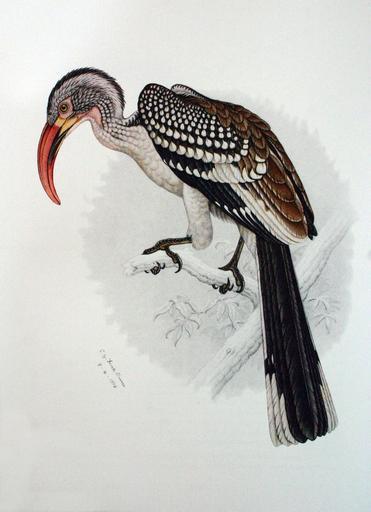MAKE A MEME
View Large Image

| View Original: | Tockus_rufirostris_by_Finch-Davies_1918.jpg (1267x1749) | |||
| Download: | Original | Medium | Small | Thumb |
| Courtesy of: | commons.wikimedia.org | More Like This | ||
| Keywords: Tockus rufirostris by Finch-Davies 1918.jpg ™‚ Tockus erythrorhynchus rufirostris <small> Sundevall 1850</small> 'n Volwasse Rooibekneushoringmannetjie Volwasse mannetjies is herkenbaar aan die lang snawel en swarterige ondersnawel Die ras soms beskou as 'n spesie is herkenbaar aan die bleek iris rosige oogring en aansienlik gestreepte nek An adult male Southern Red-billed Hornbill Adult males are recognizable by the long bill and swarthy lower mandible The race sometimes considered a species is distinguishable by the pale iris pink eye-ring and extensively streaked side of the neck The above specimen is likely from a farm near Windhoek Namibia and Finch-Davies had evidently been gaining experience of both the Southern and Damaraland species for some time <small>Tsumeb S W A 1 12 1916</small> <small>I found this species common at Tsumeb and Otavifontein and it probably occurs all through Northern Damaraland and Ovamboland; how far south it may be encountered in Damaraland I cannot say but I collected some specimens at Okanjande which appear to belong to this species; probaby about here it meets or merges into L e damarensis In habits the species exactly resembles the previous bird but I found it more universally scattered over the bush country and not as confined to river banks I have often seen it feeding on the ground digging up the soil and dead leaves with its bill evidently after insects At Otavifontein when General Botha's brigade was camped there in July 1915 it was exceedingly common and very tame flocks of them frequenting the horse lines old camping grounds and slaughter places presumably in search of insects This specimen was particularly heavily marked with grey about the head and neck; many specimens are much lighter but all considerably more marked than those from farther south L damarensis <ref> Cite book Kemp Alan The Bird Paintings of C G Finch-Davies Winchester Press Johannesburg 1984 0-620-07457-4 </ref></small> Transvaal Museum Pretoria 1918-04-09 Creator Claude Gibney Finch-Davies PD-old-auto-1923 1920 Reference reflist Tockus rufirostris Claude Gibney Finch-Davies | ||||